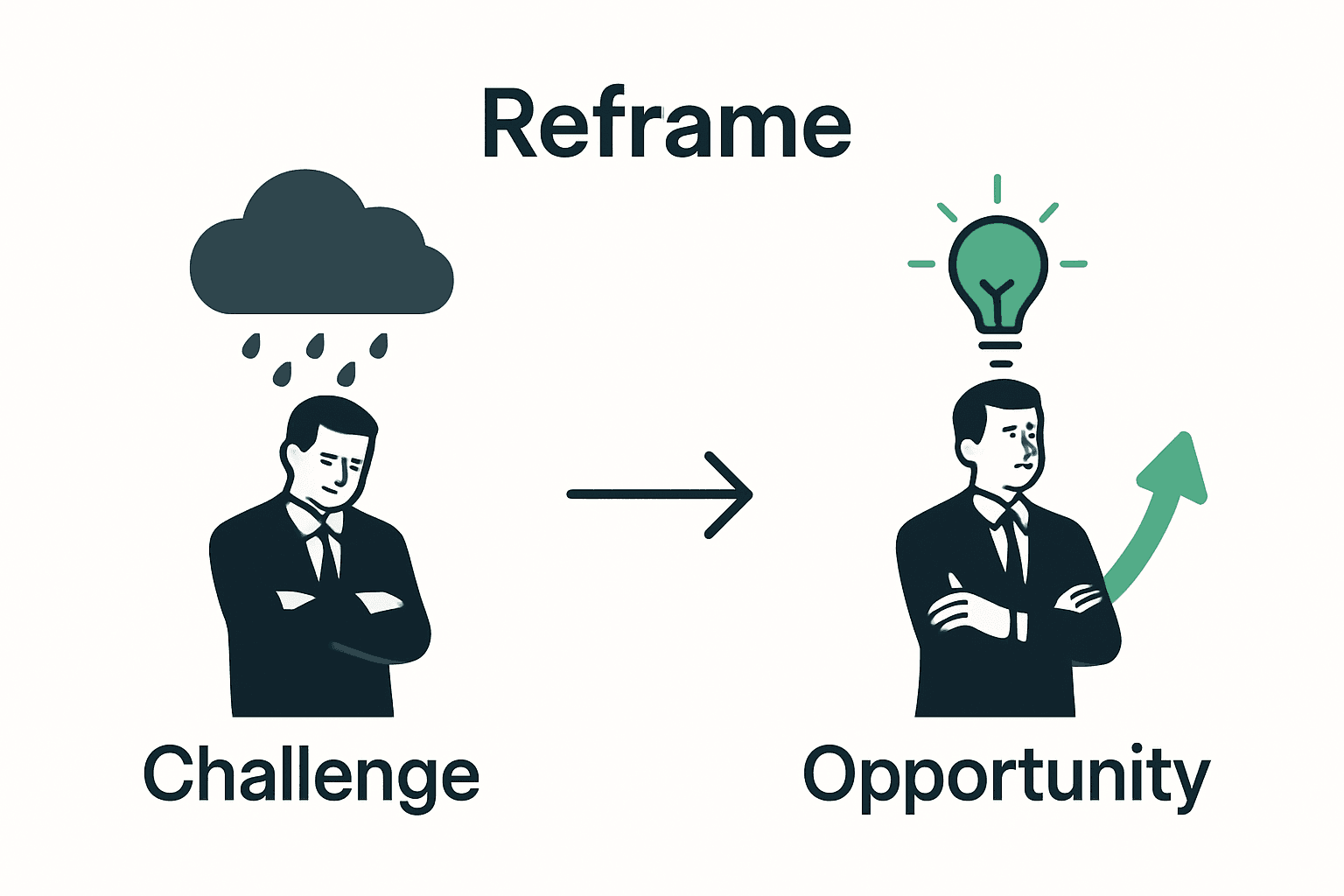Most people underestimate just how much their mindset can shape everyday outcomes. Studies show that cognitive reframing techniques can actually boost resilience and problem-solving abilities in business leaders. Understanding how to reframe thoughts is not just a psychological trick, but a practical tool that can change how you handle setbacks and create new opportunities. This guide unpacks the core ideas behind reframing and mindset transformation, offering real strategies for those who want to think differently and succeed.
Table of Contents
- Defining Reframing and Mindset Transformation
- Types of Reframing Techniques Explained
- How Reframing Shapes Entrepreneurial Mindset
- Practical Reframing Tools for Business Leaders
- Common Challenges and Pitfalls to Avoid
Key Takeaways
| Point | Details |
|---|---|
| Understanding Reframing | Reframing shifts how experiences are perceived, enabling transformation of negative thought patterns into constructive perspectives. |
| Mindset Transformation | A growth-oriented mindset enhances interpretation of challenges, turning setbacks into opportunities for learning and strategic growth. |
| Effective Techniques | Successful reframing involves emotional distancing and questioning assumptions, allowing for clearer perspectives and enhanced decision-making. |
| Challenges to Reframing | Entrepreneurs may face cognitive rigidity and emotional defensiveness; overcoming these requires consistent practice and emotional intelligence. |
Defining Reframing and Mindset Transformation
Reframing represents a powerful psychological technique that fundamentally transforms how we perceive and interact with our experiences. According to Wikipedia, cognitive reframing involves “identifying and altering the way situations, experiences, or emotions are perceived” with the goal of shifting negative thought patterns into more constructive perspectives.
Mindset is more than just a mental state – it’s an established framework of attitudes that profoundly influences our interpretations and responses. As Wikipedia defines it, a mindset encompasses “beliefs, values, and perspectives that shape one’s interpretation of experiences.” This means our mindset acts like a lens through which we view and process everything happening around us.
At its core, reframing is about intentional perspective shifting. When entrepreneurs encounter challenges, reframing allows them to transform obstacles into opportunities. Instead of seeing a failed product launch as a defeat, a reframed perspective might view it as valuable market research and a crucial step toward future success. This cognitive approach isn’t about toxic positivity, but about developing resilience and adaptive thinking.
The transformation happens through deliberate mental strategies. Key elements of effective reframing include:
- Recognizing automatic negative thought patterns
- Challenging existing interpretations of events
By understanding and practicing reframing, business leaders can develop more flexible, growth-oriented mindsets that turn potential setbacks into strategic learning experiences. Learn more about mindset coaching for business owners to dive deeper into these transformative techniques.
Types of Reframing Techniques Explained
Reframing techniques offer entrepreneurs and professionals powerful strategies to transform their mental approach to challenges. According to Learn Mental Models, these techniques are primarily categorized into two fundamental approaches: content reframing and context reframing.
Content reframing involves shifting the focus within a specific situation, allowing individuals to see alternative interpretations of the same event. For instance, a business setback might initially seem like a failure, but content reframing helps you recognize it as an opportunity for learning and strategic recalibration. Changing Minds suggests that this approach fundamentally alters the meaning inferred from a situation through perspective-shifting.
Context reframing takes a different approach by changing the entire framework in which an experience is understood. This technique involves deliberately altering the surrounding circumstances to generate new insights. An entrepreneur might reframe a challenging client interaction by considering it within a broader professional development context, transforming a potentially frustrating moment into a valuable skill-building experience.
The most effective reframing techniques typically involve:
- Emotional distance and objective observation
- Questioning initial assumptions
- Exploring alternative interpretations
- Seeking positive or constructive perspectives
By mastering these reframing techniques, business professionals can develop more resilient, adaptive mindsets that turn potential obstacles into strategic opportunities. Learn more about mindset coaching for business owners to further develop these transformative skills.

How Reframing Shapes Entrepreneurial Mindset
Reframing is a transformative approach that fundamentally reshapes how entrepreneurs perceive and respond to business challenges. According to ArXiv, cognitive reframing helps individuals “overcome negative thoughts by replacing them with more hopeful perspectives,” which directly enhances decision-making and resilience—two critical components of a successful entrepreneurial mindset.
The power of reframing lies in its ability to turn potential obstacles into opportunities for growth. Wikipedia describes this process as transformative learning, which involves a fundamental perspective shift often triggered by challenging experiences. For entrepreneurs, this means transforming a failed product launch from a defeat into a valuable learning experience, or viewing a rejected pitch as market research that can inform future strategies.
Entrepreneurial mindset transformation through reframing typically involves several key cognitive shifts:
- Viewing failures as learning opportunities
- Replacing self-limiting beliefs with growth-oriented thinking
- Developing emotional agility in face of setbacks
- Cultivating a proactive problem-solving approach
By consistently practicing reframing techniques, entrepreneurs can build remarkable mental resilience.
This approach doesn’t just change how they see individual challenges—it fundamentally rewires their approach to business, turning potential roadblocks into strategic stepping stones. Explore our guide to money mindset tips for entrepreneurs to dive deeper into transformative entrepreneurial thinking.
Practical Reframing Tools for Business Leaders
Business leaders require strategic tools to transform their cognitive approach to challenges. According to Learn Mental Models, leaders can employ content and context reframing techniques to shift perspectives, enhance decision-making, and foster innovation within their organizations.
Perspective-shifting emerges as a powerful reframing tool. Changing Minds highlights that contextual adjustments enable leaders to “alter the meaning inferred from situations,” facilitating more effective problem-solving and strategic planning. This involves deliberately changing how a business challenge is interpreted—transforming a market rejection from a failure into an opportunity for product refinement.
Practical reframing tools for business leaders include:
- The “What If” scenario exploration technique
- Reverse assumption challenging
- Multiple stakeholder perspective analysis
- Emotional distancing and objective assessment
These techniques are not just theoretical constructs but actionable strategies that can fundamentally reshape how leaders approach complex business scenarios. By consistently practicing these reframing methods, entrepreneurs can develop more resilient, adaptive leadership approaches that turn potential obstacles into strategic opportunities. Explore our guide to business mindset coaching to further develop these transformative leadership skills.
Common Challenges and Pitfalls to Avoid
Reframing is a powerful technique, but it’s not without significant challenges. Wikipedia highlights that cognitive restructuring involves “identifying and disputing irrational or maladaptive thoughts,” a process that can be remarkably difficult due to deeply ingrained cognitive distortions and natural resistance to change.
One of the most critical pitfalls entrepreneurs encounter is cognitive rigidity—the tendency to become trapped in existing thought patterns. According to Wikipedia’s Common Factors Theory, many individuals struggle because they focus exclusively on specific reframing techniques while overlooking the fundamental psychological mechanisms that drive genuine perspective shifts.
Common challenges in reframing include:
- Unconscious attachment to existing belief systems
- Fear of vulnerability during perspective transformation
- Difficulty distinguishing between realistic and distorted thinking
- Emotional defensiveness that blocks alternative interpretations
- Lack of sustained practice and commitment
Successful reframing requires more than just intellectual understanding—it demands consistent practice, emotional intelligence, and a willingness to challenge deeply held assumptions. By recognizing these potential obstacles, entrepreneurs can develop more strategic approaches to mental flexibility. Explore our guide to personal growth strategies to further develop your transformative mindset skills.

Unlock the Power of Reframing to Transform Your Entrepreneurial Mindset
If you are struggling with cognitive rigidity or find it difficult to shift negative thought patterns, this comprehensive guide on reframing offers valuable insights that can reshape your business approach. The article emphasizes how intentional perspective shifts can turn setbacks into strategic opportunities and help you develop resilience, emotional agility, and growth-oriented thinking. These are exactly the mental tools you need to break free from limiting beliefs and unlock sustainable entrepreneurial success without burnout.

Ready to put these transformative concepts into action? Explore how mindset coaching for business owners empowers you with tailored strategies to reframe obstacles and grow confidence. Combine this with proven money mindset tips for entrepreneurs and leadership guidance at SimoneCR.com for a holistic approach that blends inner work with practical business systems. Don’t wait to evolve your mindset and performance. Start your transformation today.
Frequently Asked Questions
What is reframing and how does it impact mindset?
Reframing is a psychological technique that involves altering how we perceive situations, experiences, or emotions. By shifting perspectives, reframing helps individuals transform negative thought patterns into more constructive views, thereby impacting their overall mindset positively.
How can entrepreneurs utilize reframing to overcome challenges?
Entrepreneurs can leverage reframing to turn obstacles into opportunities for growth. By viewing setbacks, such as failed product launches or rejected pitches, as learning experiences, they can cultivate resilience and adaptive thinking.
What are the key techniques for effective reframing?
Effective reframing techniques include content reframing, where the focus shifts within a specific situation, and context reframing, where the broader framework of an experience is altered. Other useful strategies involve questioning initial assumptions, exploring alternative interpretations, and maintaining emotional distance for objective assessment.
What common challenges do people face when attempting to reframe their thoughts?
Common challenges include cognitive rigidity, attachment to existing beliefs, fear of vulnerability, and emotional defensiveness. These obstacles can hinder the process of shifting perspectives, making it essential to practice reframing consistently and develop emotional intelligence.



